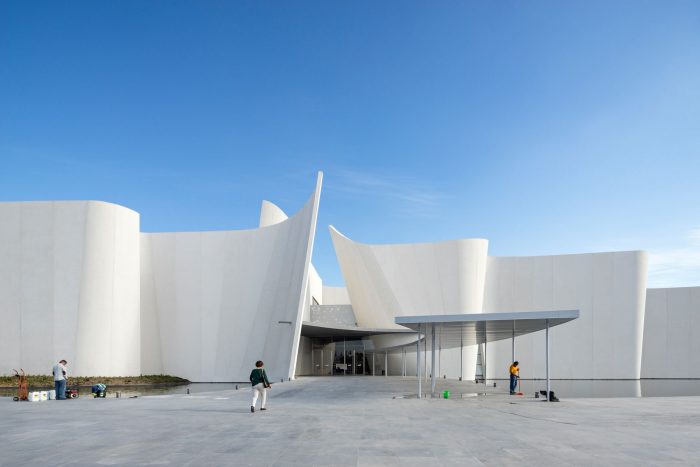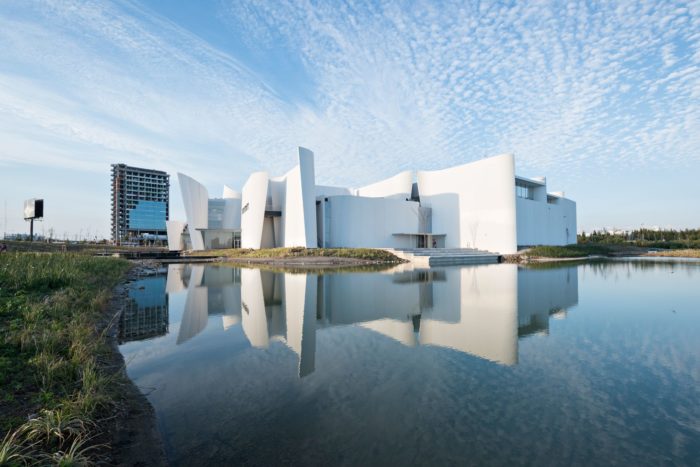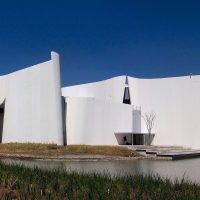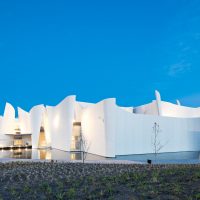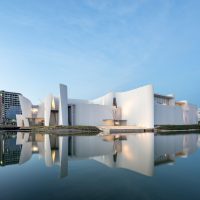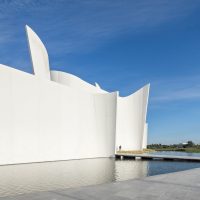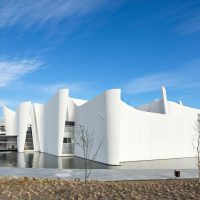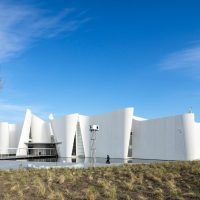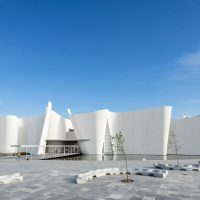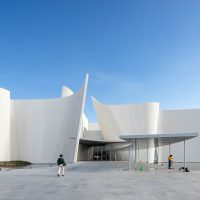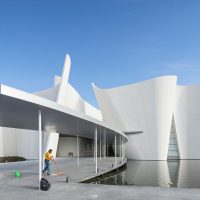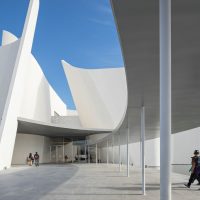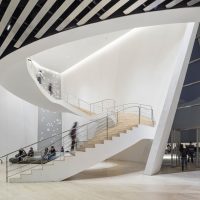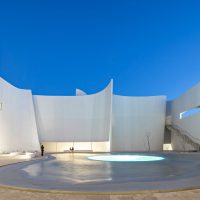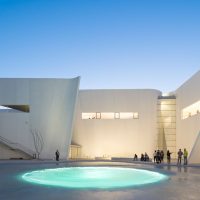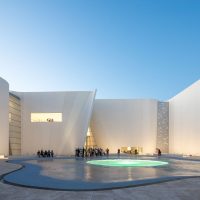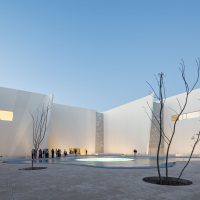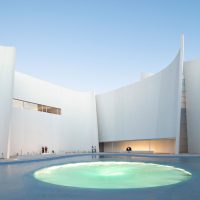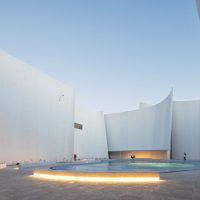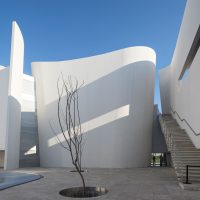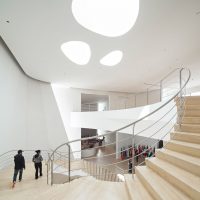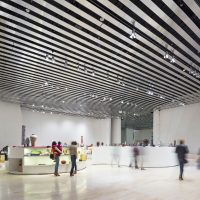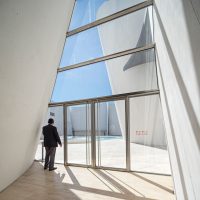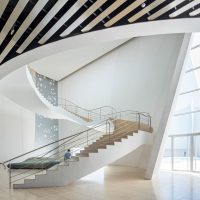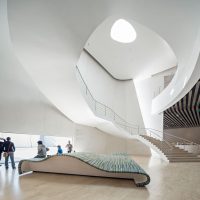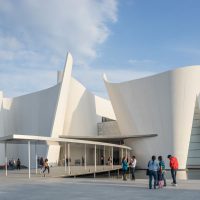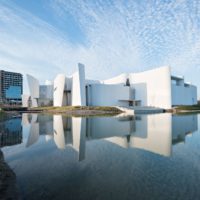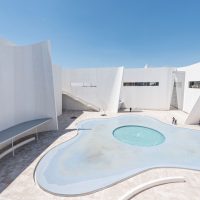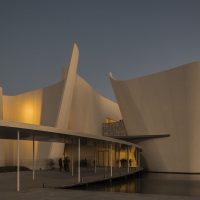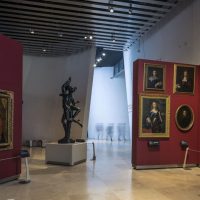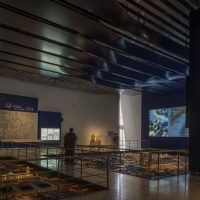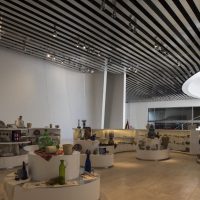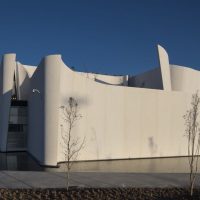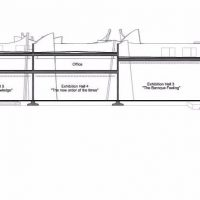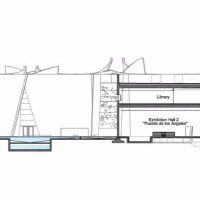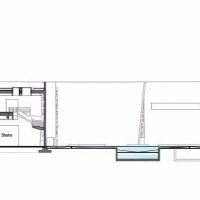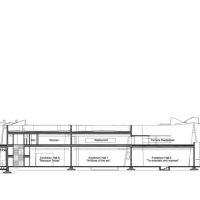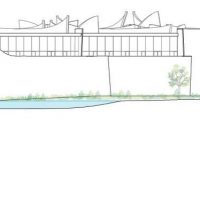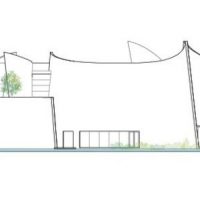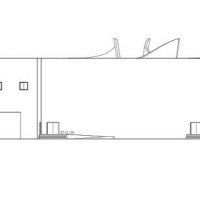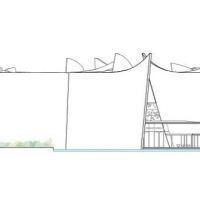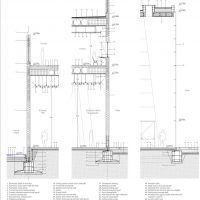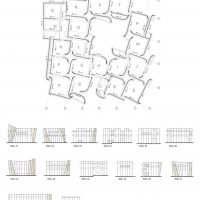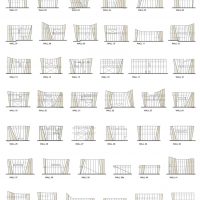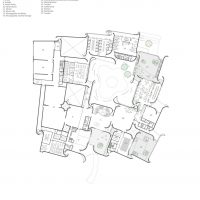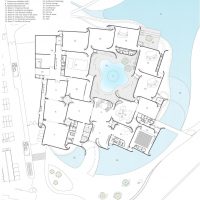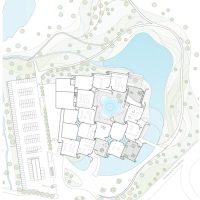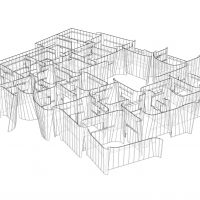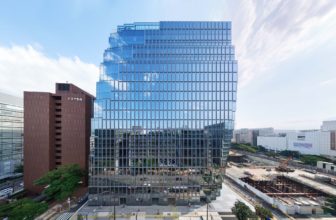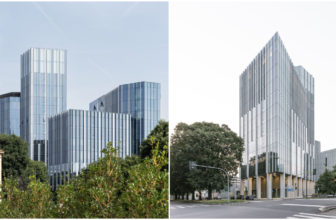Museo Internacional del Barroco designed by Toyo Ito & Associates, The plot of five hectares is located approximately seven kilometers from the city center of Puebla, at the intersection of the “Boulevard de Atlixcayotl” and the “Avenida de las Torres”. Currently, access to the site is either by car, by a public transport bus system or by a bike path circuit connecting the Museum with other parks and public spaces in the city. Parking is organized on 2 levels on the eastern side of the Museum and has about 440 boxes, parking for 4 buses, 42 motorcycles and 50 bicycles.
To frame the main facade of the museum a large square has been designed which receives the incoming visitors. It includes a passenger drop-off point for buses and cars, benches, information banners, a large stepping bench for giving explanations to visiting groups, and an entrance canopy which welcomes and protects the visitors waiting to enter the museum. This facade will also receive nighttime projections of images related to current exhibitions, which also illuminate the museum and make it stand out from a distance.
The building, 19.52 m maximum height, is elevated 2 m from the original ground. Thus it is easily recognizable from the two main roads, acting as a beacon. The MIB has two levels above ground. The total floor area is approximately 18,149 m2, of which 9,855 m² correspond to the lower floor (ground floor), 7,316 m² to the upper floor and 978 m2 to the mezzanine level. The structure consists of concrete walls and slabs that have been developed in collaboration with the Mexican company DANSTEK which specializes in precast concrete. The structure composed of precast walls and slabs were also developed jointly with DANSTEK. The walls are precast on the exterior and cast in-situ on the interior. The precast part, consisting of two panels of 65 mm white concrete joined as a sandwich panel, also acts as lost formwork whilst simultaneously controlling the final finish; the inside, cast on site with grey concrete, merge the pieces together with the reinforcement, producing a monolithic wall.
The exposed concrete has a bush-hammered texture, making it easy to rectify any defects to the finishes on site. The walls function as structural load-bearing walls with a total thickness of 36 cm. (Including the 2 precast concrete elements). The slab is a 70 cm deep lightweight composite with recycled hollow polyethylene (PET) spheres and semi-prefabricated precast slabs for easy and fast assembly.
As part of the structural strategy, the museum is a single rigid volume, giving the building earthquake resistant qualities. The foundation transmits vertical loads on the ground filler compacted soils. The foundation was built as a strip footing with an adjusted depth according to the requirements of outdoor spaces.
Exhibition spaces are mainly located on the lower floor. Upon entering the building one will reach the main hall, from which you can immediately access the museum exhibition areas, the auditorium as well as the upper level. The ticket office, cloakroom, museum shop and information center are also located in the main hall. In this area, one can also enjoy several large benches designed by Kazuko Fujie Atelier which were developed in collaboration with local textile artisans in Hueyapan, Puebla. This space communicates with the exhibition hall, from which you can access both the permanent and temporary exhibitions. The permanent exhibition includes a visit to eight exhibition halls, each with a different theme that provides a broad view of the various appearances of the Baroque. This includes the main subjects of art, architecture, theatre, music, literature and the influences of Baroque on everyday life. The eight rooms plus an outdoor terrace with selective views over the adjacent lake and park surround a large courtyard of 1800 m2, where visitors can take a rest freely during their visits. In this extensive patio, dominating the space we can find a large fountain designed as a swirling water motif. In the Baroque, moving water is a recurring theme; in the MIB it is a metaphor for the ‘generation’ of the museum.
The temporary exhibition is in three 400 m2 adjacent rooms, which can be used as individual halls, flexibly merged into a large hall of 1,200 m2 or configured into a medium sized 800 m2hall with one small 400 m2 hall. On this same floor, there is an auditorium with 312 seats, allowing it to be used independently for other cultural uses or serving the adjacent exhibition areas at different times. The ceiling height of these rooms is 6.5 m.
Rooms related to research, education, and dissemination of Baroque art are located on the upper floor. Visitors can observe the restoration process of Baroque works of art, seek reference original documents in the specialized library, playfully learned about the Baroque in the educational link (both children and adults), and enjoy the baroque flavors in the restaurant with a terrace overlooking the park. Also on this floor is the “International Baroque Saloon”, where international experts on this period will gather for symposiums. This space can also be used in connection with the auditorium below, depending on the nature and size of the event.
The museum offices are located on the upper floor at a privileged location overlooking the park, allowing the curatorial staff to be at a creative work environment for fresh and innovative exhibitions.
All internal and ‘back of house’ functions are organized on the eastern side of the building. Loading and unloading, the transit storage and the quarantine room are located on the lower floor; on the upper floor, we find the collections storage, restoration workshop, museography storage and other workshops. These two levels are connected by a service elevator with the dimensions of 7 x 4 m and 4 m height and a capacity of 12 Tons.
All rooms that hold works of art have strict temperature and humidity control, separated from the public areas, to preserve the artwork at its optimal conditions. This control can be adapted individually to each room providing maximum flexibility.
The Museum was carefully designed to meet international standards and special requirements documented in the “Facility Report”, in order to guarantee safety to the works on loan from other institutions or museums. Moreover, the museum wishes to explore innovative and interactive means to exhibit artworks from a past era using new technology.
The MIB will be a cultural meeting center, not only for Mexico but embodies international ambitions. People from around the world will gather here and exchange their thoughts and reflections. This cultural institution will become a timeless point of attraction to the world and represents pride and joy for the people of Puebla.
Project Info:
Architects: Toyo Ito & Associates
Location: Via Atlixcayotl, Reserva Territorial Atlixcáyotl, Corredor Comercial Desarrollo Atlixcayotl, Puebla, Pue., Mexico
Architectural Project: Toyo Ito & Associates, Architects
Local Architect: Federico Bautista Alonso
Area: 18149.0 m2
Project Year: 2016
Photographs: Patrick Lopez Jaimes / Danstek, Luis Gordoa
Manufacturers: Muebles Cook, Novotech, Danstek
Project Name: Museo Internacional del Barroco
- photography by © Patrick Lopez Jaimes / Danstek
- photography by © Patrick Lopez Jaimes / Danstek
- photography by © Patrick Lopez Jaimes / Danstek
- photography by © Patrick Lopez Jaimes / Danstek
- photography by © Patrick Lopez Jaimes / Danstek
- photography by © Patrick Lopez Jaimes / Danstek
- photography by © Patrick Lopez Jaimes / Danstek
- photography by © Patrick Lopez Jaimes / Danstek
- photography by © Patrick Lopez Jaimes / Danstek
- photography by © Patrick Lopez Jaimes / Danstek
- photography by © Patrick Lopez Jaimes / Danstek
- photography by © Patrick Lopez Jaimes / Danstek
- photography by © Patrick Lopez Jaimes / Danstek
- photography by © Patrick Lopez Jaimes / Danstek
- photography by © Patrick Lopez Jaimes / Danstek
- photography by © Patrick Lopez Jaimes / Danstek
- photography by © Patrick Lopez Jaimes / Danstek
- photography by © Patrick Lopez Jaimes / Danstek
- photography by © Patrick Lopez Jaimes / Danstek
- photography by © Patrick Lopez Jaimes / Danstek
- photography by © Patrick Lopez Jaimes / Danstek
- photography by © Patrick Lopez Jaimes / Danstek
- photography by © Patrick Lopez Jaimes / Danstek
- photography by © Patrick Lopez Jaimes / Danstek
- photography by © Patrick Lopez Jaimes / Danstek
- photography by © Patrick Lopez Jaimes / Danstek
- photography by © Patrick Lopez Jaimes / Danstek
- photography by © Patrick Lopez Jaimes / Danstek
- photography by © Patrick Lopez Jaimes / Danstek
- photography by © Patrick Lopez Jaimes / Danstek
- photography by © Patrick Lopez Jaimes / Danstek
- section
- section
- section
- section
- section
- section
- section
- section
- section
- plan
- diagram
- plan
- plan
- plan
- iso


